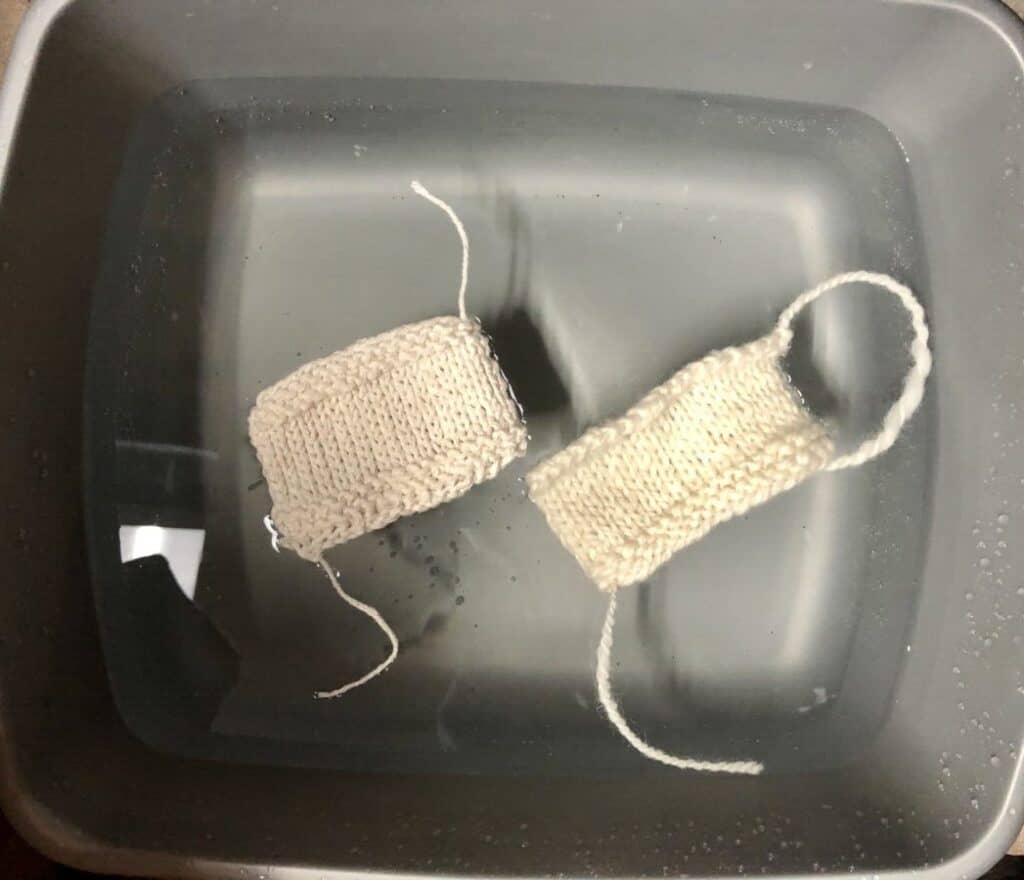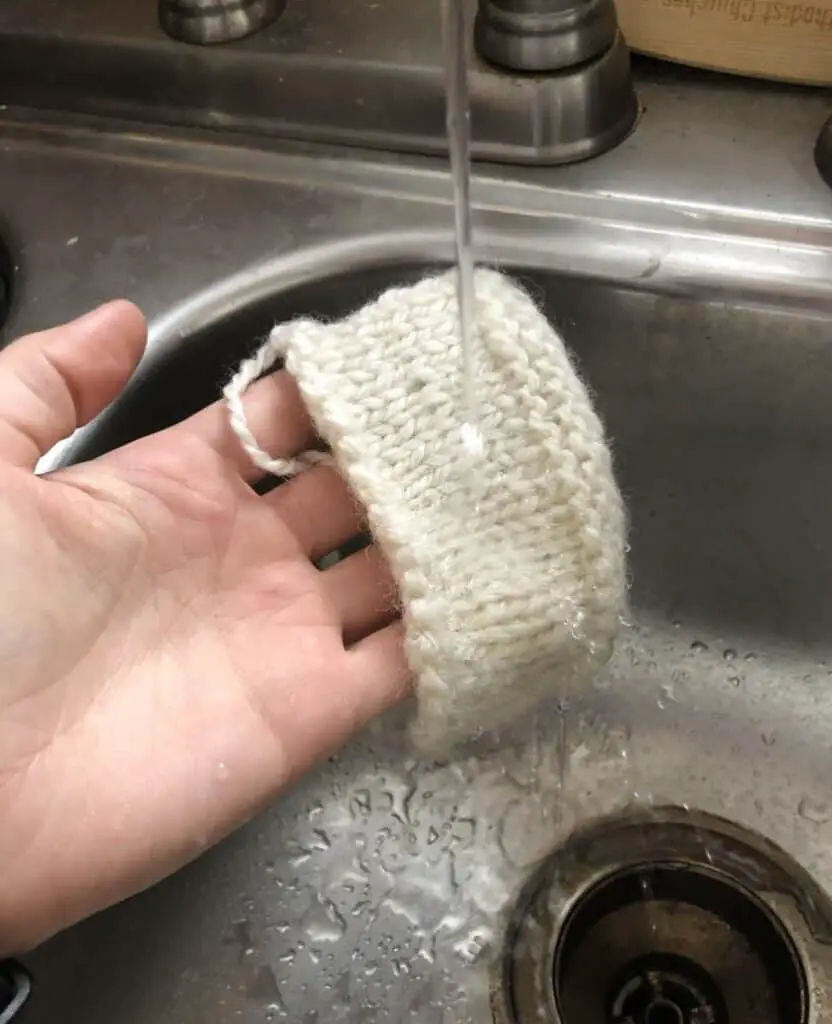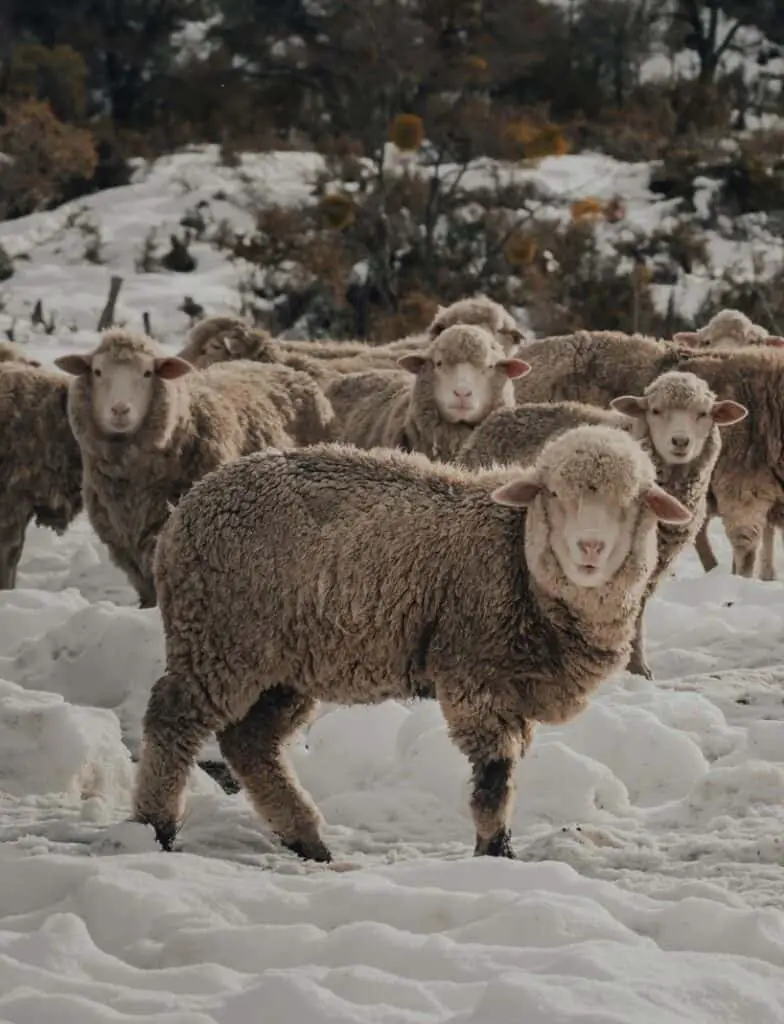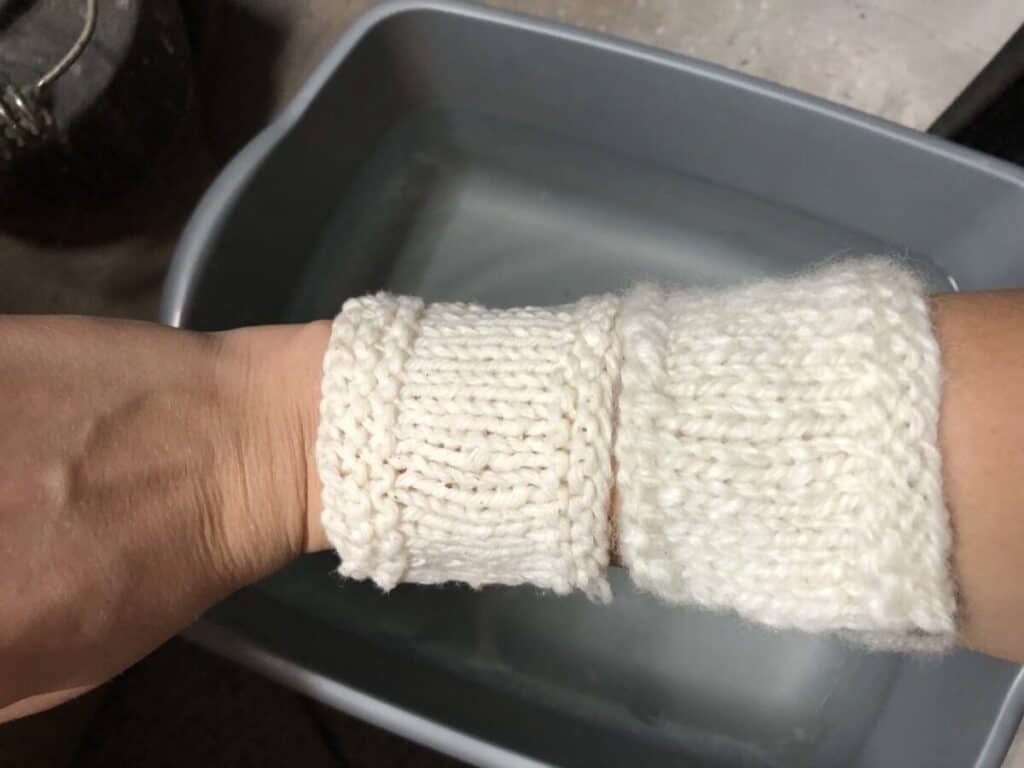Ah, the mysteries of wool. This wonder fiber has quite a few tricks up its sleeve. Thinking about wool might make you wonder about such things as; does wool absorb water and does wool float.
Dry wool will float on water but once it becomes saturated with water it will sink. However, wool takes a long time to absorb water, nearly four times as long as cotton.
We’ll take a look at the properties that make wool float as well as how and why it can absorb so much water. We’ve got a lot to cover so let’s get started.
Table of Contents
Does Wool Float?
Wool is an incredible material, it can keep you warm in the winter, warm when you’re wet, wick moisture, and, yes, even float.
Dry wool can float on water for quite a while. I conducted an experiment just to see how long it would float on top of the water. I knitted a wool swatch (a fancy name for a square) and threw it on top of a tub of water. I made one out of cotton too, just for comparison.

The swatch on the right is wool, and the swatch on the left is cotton. I sat the water next to me while I wrote this post so I could time it and keep an eye on it.
I checked the tub every 5 minutes and took a picture every time. At 5 minutes, the cotton had already begun to absorb some water and the wool was still sitting pretty on the surface.
At 10 minutes, it was the same story, the cotton had absorbed more but the wool seemed untouched. Same thing at 15 minutes.
The cotton sank to the bottom of the tub at around 19 minutes and 15 seconds. Keep in mind that this is without any outside interference. If I had dunked the cotton in the water, it would’ve sunk right there.
But, the story of the wool still continues, 20 minutes in, and, other than floating around the tub a little, the wool is unchanged. So, let’s see how long it takes for the wool to soak through with water.
At around 30 minutes, the first hint of water soaking through the wool appeared. At 55 minutes, the wool was nearly soaked through but still going strong. At 1 hour and 20 minutes, the wool finally took in so much water that it sank.
I probably had way more fun doing that experiment than I should have, but it keeps me out of trouble. I even did an additional experiment with the wet swatches in one of the next sections. Stay tuned!
From this experiment, we can see that wool takes about four times as long to absorb water as cotton does.
How can this be possible, you ask? Well, I just so happen to know. Keep reading to find out about wool and its water-adsorbing properties.
Does Wool Absorb Water?

This is actually an interesting question. Wool doesn’t absorb water, it adsorbs it. Now you’re probably looking at that thinking ‘those are the same words!’, well they’re actually not. They both relate to how materials react to water but they are very different processes.
Absorb is the word we normally use when talking about how a material sucks up water. When something is absorbent, the water soaks in between and through the fibers of the material creating a mix of water and fiber. Most materials are absorbent, like the cotton we used in our previous experiment.
Wool, on the other hand, is actually aDsorbent. When a material is adsorbent, water actually attaches itself to the outside of the fiber instead of soaking into it creating a bond between the water and the wool instead of a mix.
Mind blown! I know I was amazed when I learned this awesome science fact.
Because of these adsorbent properties, wool can do a whole host of cool things when it gets wet. Let’s dig into the meat and potatoes of wet wool.
3 Facts About Wet Wool

Wool is adsorbent, that’s great. But, what does that mean for the wool?
Because wool is adsorbent, this means that it won’t get saturated as quickly as other fibers, it doesn’t lose its insulating properties when it’s wet, and (another mind-blowing fact) it can actually produce heat while it’s drying!
Let’s break these down and talk about each one.
1. Slow Saturation
Because wool is adsorbent instead of absorbent, water doesn’t saturate the fibers themselves, it clings to the outside of the fiber. This means that when you have a bundle of these fibers, like in yarn, it’s difficult to get through to the middle of the bunch of fibers because they get stopped by the other water molecules clinging to the outside of the wool.
That was a lot, but let me try to simplify it.
Think of it as a bottleneck at the entrance to a store having a super sale.
The water in the back wants to get into the middle of the fabric, but all the water at the front is in the way. In order for the water in the back to get to the front, the water in the front has to first push its way through the wool fiber to make room for the rest of the water.
Yes, I did just compare water molecules to a Black Friday Sale. But it makes sense, right?
This isn’t the only reason that wool is slow to saturate though.
The other reason is that wool just doesn’t like water. In other words, wool is naturally water-resistant.
Water will slip off wool for quite a while before it actually attaches itself to the wool.
Water vapor, on the other hand, wool absolutely loves.
It will readily accept water vapor into its fiber but it also releases water vapor depending on the rise and fall of the temperatures the wool is in.
We’ll talk more about it in the next two sections. Read on!
2. Keeps Insulating Properties
One of the things everyone raves about when it comes to wool is that it keeps its insulating properties even when it’s wet.
How does it do that?
It does this in three different ways. The first has to do with the structure of the wool, the second has to do with the fact that wool is moisture-wicking, and the third is because it’s adsorbent. Let’s talk about structure first.
When we’re talking about insulation, one of the best insulators on Earth is air. What this means for clothing and wool products is this: the more air a material can trap, the better insulator it will be. That’s why those big, poofy, down coats keep you so warm in the winter.
As we all know, wool is pretty fluffy. But, other than making it soft and lofty, this fluff helps trap air which makes it an excellent insulator.
This is great for when the wool is dry, but what happens when it gets wet?
Because of wool’s structure, it can absorb water but also keep lots of air as well. Weird, right? It goes back to the fact that wool is slow to saturate. The longer it takes water to fully saturate the wool, the easier it is for wool to keep air trapped inside.
That means that, even though it might be wet, it can still insulate you because it still has air trapped inside. Other fibers, like cotton, do not have the ability to trap air even when wet.
Next on our list of cool wool characteristics is that it’s moisture-wicking. When a material is moisture-wicking that means that it pulls moisture away from the surface of the skin.
Wool is pretty good at this which means that if you have a wet wool hat, instead of feeling soggy and wet while wearing it, you actually don’t feel the moisture very much at all.
This helps with insulation because it means your body doesn’t have to warm up that moisture on your skin which in turn means you have more energy to heat your own body.
I did a bonus experiment after the wool vs cotton experiment I did earlier. After I took the swatches out of the water, I squeezed them out to get any excess dripping water off, then I put them both on my arm to wear them around for a while to test which one feels better on your skin while wet.

I know I probably sound like a crazy sheep lady, but hey, anything for you guys.
What I discovered just reinforced everything I’ve said so far, the thing that was surprising, though, was how big of a difference there was between the two.
I only had them on my arm for about five minutes before I could tell a noticeable difference in the feeling. The cotton swatch was much, much colder on my skin than the wool. I could barely feel the wool on my skin at all.
When I touched my skin under the wool swatch it was toasty warm, as opposed to the damp, cold skin under the cotton swatch.
The skin under the wool swatch was also significantly drier than the skin under the cotton swatch.
See? Told you wool was awesome.
Alright, enough of my wool praise, let’s get back to the science.
The next section talks about the third way wool keeps you warm while wet.
3. Produces Heat While Drying
The first time I learned about this I definitely didn’t believe it. But, after doing some research and learning more about what it means for a material to be adsorbent, it makes total sense. Let’s break it down.
We talked a little bit about what it means to be adsorbent but let’s talk about it again to make sure we have all the details.
When a material is adsorbent, it makes a weak molecular bond with the water instead of the water just being mixed in with it.
This weak molecular bond between wool and water is what makes all of this possible.
When wool starts to dry, it has to let go of the water. In more sciency terms, the wool has to break the molecular bond with the water.
The breaking of this bond is something called an exothermic reaction. All that means is it is a heat-producing reaction.
So, when wool is drying, every time it breaks a bond with water, it produces a little bit of heat.
Multiply that little bit of heat by the millions of water molecules connected to the thousands of wool fibers, you have a toasty little oven.
I know all that is pretty awesome, but wait! There’s more!
Wool doesn’t just do this while it’s drying, it also does this for temperature changes. If you’re outside in the cold and wet of winter and you go somewhere that’s a few degrees warmer or colder, or even wetter or dryer, your wool garments will adjust to the new environment by releasing or adsorbing moisture.
Absolutely wild.
You may not be as excited about this as I am but if you are and you want to know more, check out this paper written by a scientist from Australia.
Wrap up
We covered a lot of ground on the science behind how wool works, let’s review to make sure you know your stuff.
Wool does sink, but only after it’s fully saturated with water. In my little experiment, it took wool an hour and twenty minutes to get soaked with water which is four times as long as it took the cotton sample.
Wool is actually adsorbent instead of absorbent. This means that instead of getting soaked through with water, it actually creates a weak bond with the water.
This adsorption means the wool is slow to saturate with water, it keeps you insulated when it’s wet, and it produces heat while it dries by breaking those weak bonds.
I know we covered a lot of information, but I hope you learned something new today, I know I did!
Now, go make something awesome out of wool!

